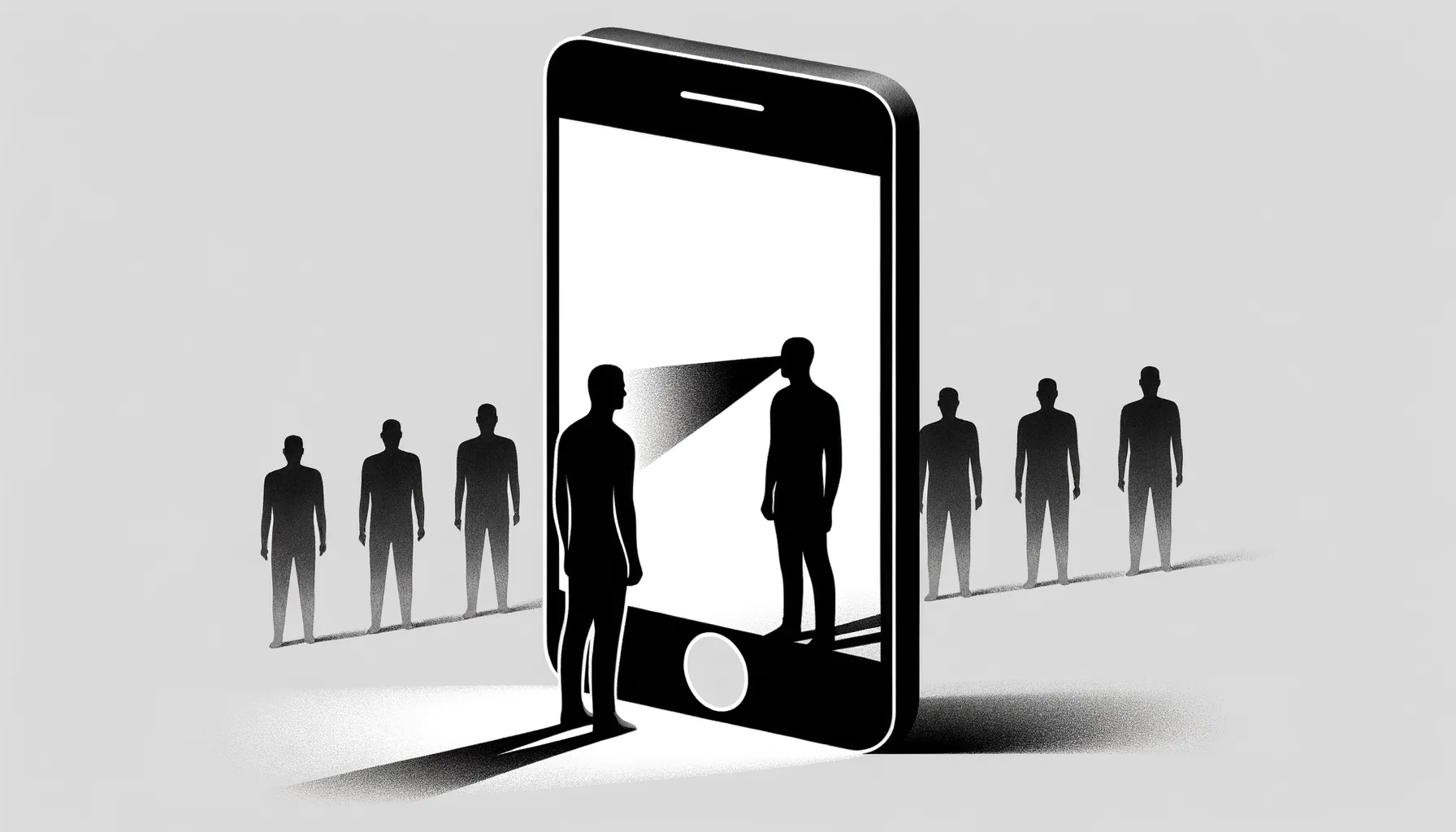- 0 Comments
- Views 51
- Unveiling the Hidden Truth
- The Digital Tell-Tale: Decoding His Texting Habits
- The Secret Code of Smiles and Laughs
- When the Phone Becomes a Barrier
- The Mysterious Case of Sudden Plans
- Why He’s Always Busy Without You
- The Sudden Surge of ‘Friend’ Gatherings
- When Silence Speaks Volumes: The Sound of Secrecy
- Accidental Slips: The Name-Dropping Dilemma
- Listening to Your Instincts: The Gut Feeling Factor
- Understanding the Signals: FAQs on Relationship Dynamics
- What are the typical behaviors of someone who is talking to another person?
- How do I approach my partner if I suspect he is talking to someone else?
- Is it normal to have a gut feeling that my partner is not being truthful?
- What should I do if my partner prioritizes someone else over me?
Unveiling the Hidden Truth
Within the labyrinth of love, hidden truths are like whispers in the wind—present, yet often unnoticed until they stir the surrounding leaves. These are the small yet significant indicators that something within the harmony of our partnerships is amiss. Could it be that the person we treasure has secrets tucked away? It’s the slight change in pattern, the hesitation in a conversation, or the evasive glances that signal a story untold.
These subtle signs are the language of the unspoken, the hints that invite us to look closer and question deeper. They are the ripples on the surface that hint at the currents beneath. Acknowledging them is not an act of accusation but a step towards deeper understanding. And as we begin to recognize these signals, we learn to listen not only with our ears but with our intuition, sharpening our ability to discern the truths that lie hidden in plain sight.
Join me in exploring the nuanced dynamics of trust and secrecy, and let’s uncover what these hidden truths might mean for the future of our relationships.
“Secrecy in relationships is like a poison that slowly erodes trust and destroys the foundation of love.”
The revelation of hidden truths in a relationship is akin to turning on a light in a dim room. Suddenly, the contours of our interactions become starkly visible, and what was once ignored or unseen demands our attention. These revelations can be painful, yes, but they also bring with them a chance for realignment and growth. When secrets surface, they challenge the dynamic equilibrium we’ve established, forcing us to confront issues that may have been simmering beneath the veneer of contentment.
Trust, once compromised, enters a delicate state of flux. The implications are profound—trust must be rebuilt, or the relationship risks collapsing under the weight of doubt. We must then decide: do we shore up the foundations with renewed commitment, or do we walk away from a structure too frail to withstand the tremors of truth? The answers are seldom simple, but they are necessary for the journey toward a more authentic and resilient bond.
As we continue, let’s delve into the digital realms where much of modern communication—and miscommunication—takes place. Understanding the digital tell-tale signs is essential in today’s interconnected world.
The Digital Tell-Tale: Decoding His Texting Habits

In the digital age, our love letters have transformed into text messages, and the spaces between us are bridged with pixels and data packets. Digital communication has become the bloodstream of many relationships, carrying the life-giving force of connection—but also the potential for misinterpretation and opacity. The screen that displays affectionate emojis can just as easily mask the tension of a divided attention.
Transparency in digital conversations is a modern-day litmus test for trust. The ease with which we can connect with others also introduces ease for concealment and diversion. Is he taking longer to reply? Are his messages suddenly more guarded or sparse? These shifts in digital dialogue can be as telling as averted eyes or a hesitant voice. The key to navigating this new terrain is not paranoia but awareness—an awareness that prompts us to seek clarity amidst the static of silent screens and typing bubbles.
As we chart the landscape of texting habits, remember that each message sent or unsent can carry with it the weight of meaning. Let’s decode these signals together, and learn to listen to the digital heartbeats of our relationships.
- Sudden protectiveness over their phone, indicating a desire to shield messages from view.
- An uptick in phone usage, particularly with fervent texting that excludes your involvement.
- Immediate and enthusiastic responses to a specific individual’s messages.
- Texting during unconventional hours, suggesting secretive communication.
- A noticeable increase in flirtatious content and emoji use in texts.
- Regular deletion of text messages or clearing of chat histories.
- An unexplained shift in texting patterns, such as increased secrecy or distance.
Interpreting changes in texting habits can be like trying to read the weather in the sky—a lot of signs, not all of them clear. When we notice patterns shifting in digital communication, it’s easy to let anxiety cloud our judgment and precipitate hasty conclusions. Pause. Take a moment to breathe and step back from the precipice of assumption.
Approach these changes with a blend of rationality and sensitivity. Begin by reflecting on potential external factors—could work demands or personal stress be influencing his behavior? Engage in an open dialogue, expressing your observations without accusation. “I’ve noticed you’ve been on your phone a lot lately, is everything okay?” This invites conversation, not confrontation.
Remember, context is key. A change in texting habits doesn’t necessarily wield the flag of infidelity. It could signal a multitude of things, from a new phase in your partner’s life to a simple evolution in communication style. By approaching the subject with a calm and curious mindset, you can uncover the true nature behind the digital curtain—fostering transparency and understanding in your relationship.
The Secret Code of Smiles and Laughs
In the lexicon of texting, emojis and laughter are more than mere adornments; they are the silent envoys of emotion and intimacy. The judicious use of a winking face or a string of laughing tears can transform a plain message into an intimate whisper, a digital touch that bridges the gap between screens. When these playful characters become frequent guests in your partner’s texting conversations, it raises the question: Who is on the receiving end of such warmth?
Emojis and shared laughter create a private world within the public sphere of texting, a space where inside jokes and shared sentiments flourish. It’s the digital equivalent of a lingering gaze or a knowing smile shared across a crowded room. Their significance lies not in their presence alone, but in their context and frequency—when they start appearing more often with someone else, it’s a sign worth noting.
Let’s continue to unravel the complexities of digital communication, as we learn to discern between innocent banter and potential red flags.

In the silent symphony of texting, emojis conduct emotions, orchestrating a ballet of sentiments that leap beyond words. This visual harmony underscores the unspoken intimacy that can thrive within the digital whisper of a screen.
When the Phone Becomes a Barrier
The smartphone, once a conduit for closeness, can morph into a wall of separation with a single swipe. Phone habits, often overlooked, play a pivotal role in the ebb and flow of relationship dynamics. A partner’s sudden vigilance over their device or a new pattern of taking calls in another room—these are more than mere quirks; they are the bricks and mortar of a barrier slowly rising.
When your shared moments are punctuated by the persistent glow of a screen, the message is clear: something, or someone, is vying for your partner’s attention. Accessibility to one’s phone can be a reflection of the openness in your relationship. If that accessibility begins to wane, it’s a signal that deserves your attention. It’s essential to identify when a tool of communication turns into an instrument of isolation and to address it before the silence becomes the loudest conversation you share.
As we delve deeper into the subtleties of presence and absence, we uncover more about the silent signals of a changing relationship.

The Mysterious Case of Sudden Plans
Life’s rhythm is often punctuated by the predictable beats of a shared schedule—the morning coffee together, the evening walks, the weekend brunches. But what happens when these rhythms are disrupted without explanation? Unexpected changes in schedule can be the jarring notes in the melody of a relationship, signaling a disharmony that warrants a closer listen.
It starts subtly—a cancelled plan here, a new commitment there. But as these instances accumulate, they form a pattern that can suggest deeper issues. Is it merely the ebb and flow of life’s demands, or is there someone else’s tune playing in the background? These deviations from the norm can be red flags, alerting us to potential shifts in priority and affection.
Let’s explore how to distinguish between the benign and the telling when it comes to these schedule changes, and what they might mean for the tempo of your relationship.
| Aspect of Schedule | Typical Pattern | Sudden Change |
|---|---|---|
| Work Hours | 9 AM – 5 PM, consistent weekdays | Frequent late nights, unexplained overtime |
| Weekend Activities | Regular outings together | Increased solo activities or unavailability |
| Communication Habits | Regular check-ins and updates | Sparse or irregular communication |
| Evening Routines | Dinner together, shared leisure time | Often out, new hobbies that exclude partner |
| Holiday Plans | Spent with partner or family | Sudden trips alone or with ‘friends’ |
Our lives are often scored by the rhythm of routines, and it’s within these patterns that the harmony of a relationship plays out. When the melody changes unexpectedly, it’s not just the notes that are different—it’s the entire tune. The data in the table above isn’t just a list of changes; it’s a story unfolding. Frequent late nights at work could indicate increased responsibility or, perhaps, a diversion masking other engagements. The shift from cherished weekend outings to solo escapades can signal a desire for space—or could it be time spent in another’s company?
Communication, the thread that binds two people in a shared narrative, when frayed or sparse, can unravel the fabric of intimacy. New hobbies and evening routines that systematically exclude a partner could be a sign of personal growth, but they may also point to new allegiances being formed. And when holidays, once the pinnacle of shared joy, are spent apart without clear reason, it begs the question: Who is filling the void?
As we interpret these changes, it’s crucial to seek the story behind the data, to understand the implications for the emotional symphony of our relationships.
Why He’s Always Busy Without You
In the dance of love, shared time is the rhythm that keeps partners in sync. It’s in these moments together that we weave the threads of shared experiences, creating a tapestry rich with intimacy and understanding. When these shared moments dwindle, when he is consistently busy without you, it’s as if the music has stopped, and one is left dancing alone.
His unavailability could be the echo of a life growing in a different direction or the whisper of another presence stepping into the shared spotlight. It’s not just the absence that speaks volumes but the pattern of it. If the shared time that once was the heart of your relationship is now a rarity, it’s essential to understand the why behind this shift. It could be the harbinger of a deeper disconnection, or simply the beat of change to which your duet must adjust.
But remember, this is not the end of our exploration. In the next section, we’ll delve into the significance of those ‘just friends’ gatherings—do they represent innocent socializing, or is there more beneath the surface?
The Sudden Surge of ‘Friend’ Gatherings
Social gatherings are the salt and pepper of life, adding flavor to our daily routines. Yet, when the ‘just friends’ outings begin to pile up, it could be a signal that you’re no longer the main course. Increased ‘friend’ gatherings might seem innocuous at first glance, but their frequency and context can be telling. Is he eager to attend these outings without you, painting them as casual, yet becoming meticulous about his appearance?
This uptick in socializing away from you may reflect a need for space and individuality, which can be healthy. However, it could also hint at new connections being forged in your absence—connections that might not be as Platonic as suggested. It’s the nature of these gatherings, and his behavior surrounding them, that can stir the pot of concern.
As we peel back the layers of these social excursions, let’s keep an eye out for the nuances that differentiate harmless fun from a potential threat to your relationship.
When Silence Speaks Volumes: The Sound of Secrecy
In the tapestry of communication, silence and secrecy are threads that can both mend and fray the connections between us. Silence, when used as a sanctuary for thought, can be a powerful ally in building trust. However, when it becomes a fortress behind which secrets hide, it casts a long shadow on the landscape of trust. The absence of words, the evasion of questions, and the hushed tones of concealed conversations—these are the signs that silence has shifted from ally to adversary in the realm of communication.
Secrecy, on the other hand, is a more insidious agent. It suggests a deliberate withholding of information, a barrier erected between hearts that once promised transparency. The effects of secrecy on trust are like water on stone—slowly eroding the foundation until what remains is fragile and hollow. Trust thrives in the light of openness, and withers in the dark of secrets. As we navigate these silent waters, let’s remember that it’s not just the words spoken, but also the words unspoken, that shape the truth of our relationships.

Accidental Slips: The Name-Dropping Dilemma
Names carry weight—their utterance can be as revealing as a telltale heart beating beneath the floorboards. In the lexicon of love, a slip of the tongue, a casual mention of a new name, can be an inadvertent siren call to lurking doubts. Name-dropping, especially when it’s out of context or laced with a certain fondness, can set the stage for an emotional domino effect.
Such slips are like unexpected puzzle pieces that don’t fit into the familiar picture of your relationship. They prompt questions: Who is this person? Why have they become a note in the melody of his daily recount? The impact is two-fold—there’s the sting of potential betrayal and the internal turmoil it ignites. Your partner’s unintended revelation can spiral into a narrative of suspicion, leading you down a path of emotional unrest fraught with confusion and hurt.
Understanding the gravity of these name-dropping moments is just as important as addressing them with clarity and care. In the next section, we will focus on the power of intuition and how listening to your instincts can be your compass in the murky waters of uncertainty.
Listening to Your Instincts: The Gut Feeling Factor
At the core of our being lies an instinctual compass, one that often knows the truth before our minds accept it. When it comes to the delicate dance of relationships, this compass can feel the magnetic pull of truths unseen. Trusting your instincts doesn’t mean jumping to conclusions; rather, it’s about honoring that inner voice that nudges you towards deeper inquiry.
Addressing concerns in your relationship starts with calm, open communication. Approach your partner with genuine curiosity rather than accusations. Frame your concerns with “I” statements—expressing how specific behaviors make you feel, rather than making presumptive claims. This invites a dialogue that is less likely to put your partner on the defensive and more likely to lead to honest exchanges.
Remember, your instincts are a dialogue between your emotions and your intellect. Listen to them, use them as a guide to seek clarity, and approach your relationship with the intention to understand, not to judge. As we conclude this section, let’s carry with us the wisdom that while instincts are our silent allies, it is our actions and words that will ultimately navigate the course of our relationships.

Understanding the Signals: FAQs on Relationship Dynamics
What are the typical behaviors of someone who is talking to another person?
Typical behaviors may include frequent texting, unexplained absences, and a sudden interest in privacy. Watch for changes in routine or affection levels that seem out of character.
How do I approach my partner if I suspect he is talking to someone else?
Approach the conversation with calmness and honesty, focusing on expressing your feelings and seeking clarity rather than making accusations.
Is it normal to have a gut feeling that my partner is not being truthful?
Yes, it’s normal. Intuition is a powerful sense shaped by emotional intelligence and subconscious observations; trust it and investigate further.
What should I do if my partner prioritizes someone else over me?
Communicate your feelings openly and seek to understand the reasons behind their actions. Consider counseling to navigate this change together.







